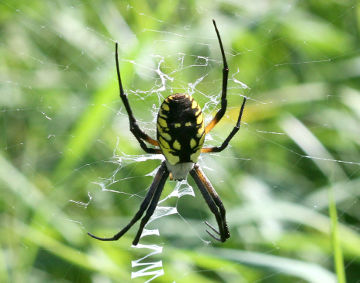Village News

PHOTO COURTESY OF GARRY KESSLER
Common garden spider
September 27, 2019, Page A5
NATURE NOTES
By Annie Reid
Westborough Community Land Trust
Common garden spider
Have you met a common garden spider? Have you noticed a large spider hanging like a garden ornament in the middle of its web? You might see it in a late-summer garden, or in an old field rich with goldenrod or other sturdy late-season weeds.
The common garden spider (Argiope aurantia), also called the yellow garden spider or black and yellow garden spider, is an orb weaver (Araneidae family). It’s found from southern Canada to Costa Rica. You might spot its large circular web, up to two feet across, with a thick zigzag line near the center. The zigzag gives the spider other names such as writing spider or zipper spider.
This spider builds its web across an opening in the surrounding vegetation. The web is a trap, the spider’s way of catching flying insects to eat – moths, flies, bees, aphids, grasshoppers, even butterflies. When an insect gets caught in the web, the spider feels vibrations in the web and hurries over to inject venom that kills the prey. The spider might eat the prey or wrap it in silk to store for later. Every night, the spider renews the web by eating and rebuilding part of it, in a kind of recycling process.
The inch-long common garden spider that you find in late summer or early fall is a female, about a year old and near the end of life. The male is much smaller, about a fourth of her size. Males wander around searching for a female and may lurk at the edge of a female’s web or weave a small web nearby. The male risks becoming prey if he walks across the female’s large web, but he usually signals her by plucking a strand of the web. After mating, the male dies. Or, well, sometimes the female eats him.
The female lays 300-1400 eggs in the night and wraps them in a ball-like, silky egg sac that’s brown on the outside. It’s one-half to an inch wide, with a neck like a vase. She attaches it near the center of the web and guards it until she dies or is killed by a hard freeze. (Remember Charlotte’s Web, the children’s book by E.B. White?) In warmer sections of the country, common garden spiders live more than one year.
The young spiders hatch in autumn but go dormant for the winter inside the egg sac. Tiny spiders emerge in spring and start to grow and mature. They spin silk strands and hang from them to travel by blowing in the breeze. They know instinctively (by genetic programming) how to build webs, using both sticky silk and silk that’s not sticky. Spider silk is both strong and stretchy. (Birds such as hummingbirds and blue-green gnatcatchers often steal spider silk to use in building their nests.) As the young spiders grow, they shed their hard, exterior skeletons several times, until males and females reach adulthood in late summer.
Are common garden spiders dangerous to humans? No, but don’t touch or handle one. They are not aggressive but can bite if harassed. The bite is similar to a bee sting (for people who are not allergic).
Enjoy this garden resident. And watch a spider – any spider – build its web, if you get the chance.
Date index
Month (September)
Common name index
Scientific name index
Category index